164 Search Results for visual schedule
April 19, 2013
by Carole Zangari -
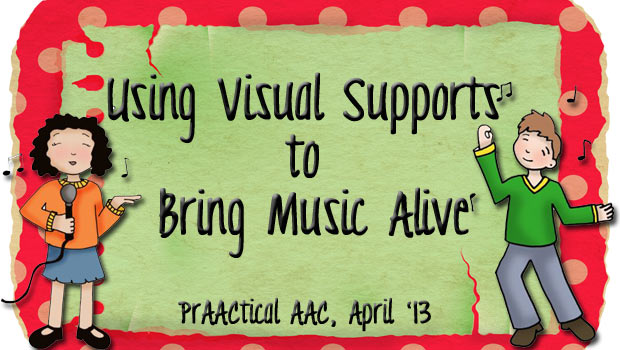
When I first met our guest blogger almost 20 years ago, she was using more visual supports in her music therapy sessions with kids who had ASD than most SLPs were using in their language therapy. Marlene Sotelo has worn many hats in her professional life, but her passion for helping people with ASD communicate more effectively seems to have permeated all of them. In this post, she discusses some of the ways she uses visual supports to help make music therapy effective. Music is a powerful force that transcends time, cultures, and languages. It can transport you to the past, and bring you hope and excitement for the future. In addition, music can be an effective tool in teaching children with varying abilities. The predictability, rhythmic patterns, and repetitive nature of the structure music lends itself to the development of language, cognitive skills, and motor skills, especially for individuals... [Read More...]
October 9, 2012
by Carole Zangari -
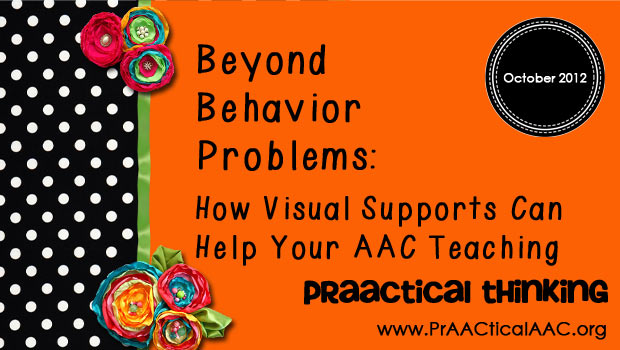
Visual supports are not just for people with behavioral challenges. In this post, we share some ideas of using visual schedules and other supports to enhance comprehension and language learning. Let’s look put this into a clinical context. Marvin is a high school student with intellectual disabilities and cerebral palsy who is learning to use a high tech SGD. He is a personable young man who engages easily and comes to each session with a ‘ready to learn’ mindset. Most of Marvin’s goals revolve on learning to build sentences using core words. Although he has very limited literacy skills, he really, really wants to learn word prediction. This presented a bit of a dilemma, as I typically don’t begin to teach word prediction until spelling skills are approaching the third grade level. Marvin has some terrific splinter skills but his overall spelling skills are probably around the mid-first grade level.... [Read More...]
July 20, 2012
by Robin Parker -
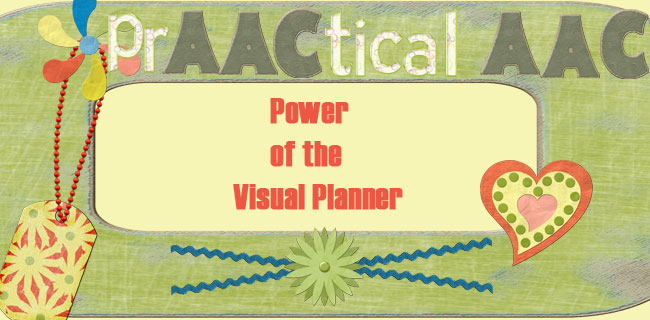
We need to continue to talk about scheduling…..especially as we talk about tools for positive behavioral supports. We know that having monthly, daily, and mini-schedules make us ALL feel more competent and calm. We have written a lot about visual schedules and visual schedule resources because we have seen schedules reduce or eliminate so many behavior challenges. They have helped with transitions, wandering away during activities, activity completion, asking repetitive ‘‘when are we going ________ questions, and with meltdowns during a less preferred activity. We also continue to write about schedules because there are still myths suggesting schedules might hinder independence when exactly the opposite is true. We personally continue to use a combination of no-tech to high-tech visual schedules, but we are loving mobile schedules especially during the summer when we are traveling and moving around from place to place even more frequently than usual. We gathered together... [Read More...]
April 11, 2012
by Carole Zangari -
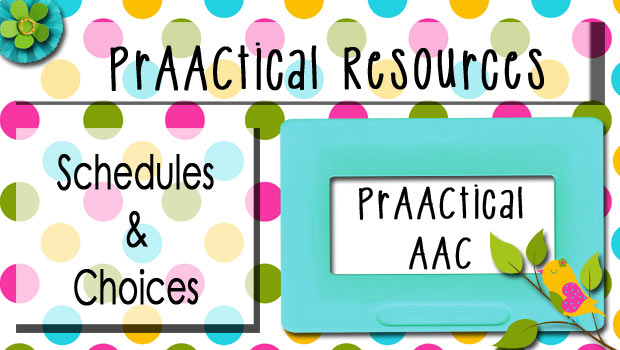
– If you follow our blog, you know that last month we had lots to say on making, teaching, and using Visual Schedules. We ran out of time before we could discuss a question that comes up a lot in our own clinical practice. What role does choice-making play in visual schedules? Here are some of the things we think about when we consider this for the schedules we make and use. We all like to have some say in what we do. Giving the learner an opportunity to make choices in a schedule makes sense when personal autonomy is a priority. Allowing the learner to choose which activities to place on the schedule supports personal autonomy: Having control over what happens in our lives is a big part of happiness for most people. – Here’s how we might do that with a visual schedule for a therapy session. 1.Select... [Read More...]
April 8, 2012
by Carole Zangari -
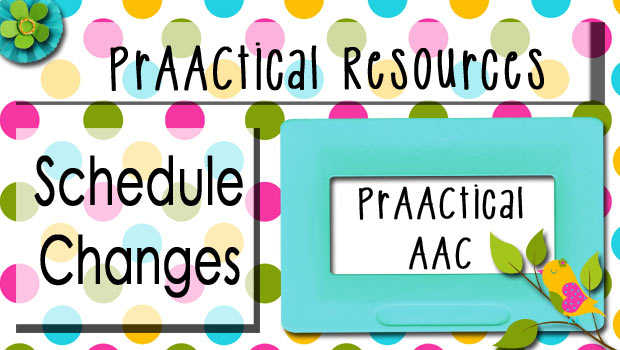
We couldn’t resist one more video about visual schedules. There are so many things we love about this one from SET BC, starting with the fact that the student sets it up. We also love hearing how they have changed the schedule to meet the student’s individual needs as he has matured. My favorite part was hearing how successfully they used a ‘Something’s Different’ symbol to indicate when an unusual activity was going to occur. – Happy viewing! – –
March 24, 2012
by Robin Parker -
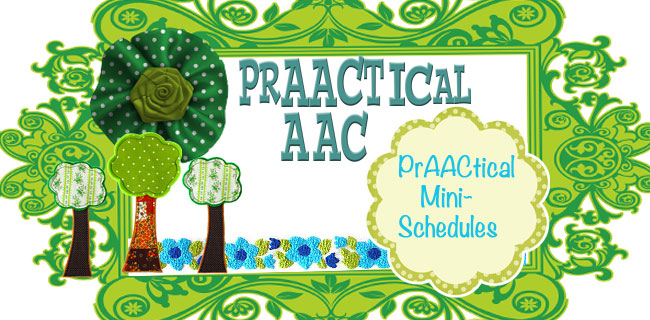
We were looking for some specific resources for a distant colleague. We wanted to get as much good information as possible because this colleague was not in our field but in another department that has direct impact over work. We do not necessarily see ‘eye to eye’ on many issues so we thought it might be helpful to our working relationship. In the process, a young man and his family would get some much-needed support. In our exploration, we found some great new videos about schedules- our topic of the month. We found several very prAACtical videos by the Watson Institute about mini schedules. We have found mini schedules to be very helpful for activities of daily living, community activities, leisure time activities and even in special event activities. We love that the Watson Institute put these on you -tube for everyone to learn from. They even have a you-tube video... [Read More...]
March 11, 2012
by Carole Zangari -

This month we’re focusing on visual schedules. Some of our AAC friends have had great success with object schedules, so we’re a little surprised that more people don’t use them. Here’s a nice video on the strategy from the wonderful team at OCALI.
February 6, 2022
by Carole Zangari -

Happy Sunday, AAC friends. Here are some posts you might enjoy. Monday – 3 Ways to Use Visual Schedules to Enhance AAC Learning Tuesday – AAC Link Up Wednesday – Video of the Week: AAC Do’s & Don’ts Thursday – Throwback Thursday: AAC-friendly Valentine’s Day Resources Friday – PráctiCAAmente Conectados Con Links – Febrero 2022 :::::::::::::::::::::::::::::::::::::::::::::::::::::::::::::::::::::::::::::::::::::::::::::::::::::::::: In the mood for a little more AAC reading? Here are some suggestions. Getting ready for a core vocabulary journey Make It Monday: Manual communication boards with core vocabulary Make It Monday: More words, please! Expanding our manual communication boards Super Size It: 5 ideas for making large communication boards Beyond requesting: A week of routines to increase AAC use at mealtimes 5 ways to build understanding Free resources for making AAC and visual supports 5 places for shared AAC materials
September 20, 2021
by Carole Zangari -
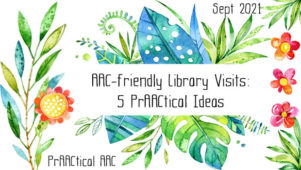
The community of AAC practitioners and families includes many people who have strong connections to their school or community libraries. In today’s post, we share some thoughts and resources on making library visits more accessible and engaging to those with AAC needs. Social narratives are a wonderful, evidence-based way to help AAC learners prepare for the experience of visiting the library. These work best when the pictures and text are customized to fit the specific library situation that the AAC learner will encounter. Here are some examples. Nicole Caldwell’s example of a social narrative Lancaster Public Library Social Narrative for Children Social Narrative for Teens Take a video tour of the library, like this one from Powell River Library. If your local library doesn’t have an online video tour, suggest that they create one or, if you’re feeling ambitious, create your own. Create a visual schedule or picture checklist for... [Read More...]
October 22, 2020
by Carole Zangari -
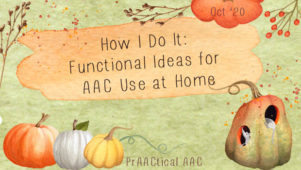
Speech-language pathologists who serve individuals with complex communication generally have less time than they’d like to support families in implementing AAC at home. In today’s post, guest author Jesse Kleinman shares her ideas for using functional activities to support AAC learning. As an SLP in Brooklyn New York, she provides in-person and remote therapy to students with AAC needs. Enjoy! ::::::::::::::::::::::::::::::::::::::::::::::::::::::::::::::::::::::::::::::::::::::::::::::::::: How I Do It: Functional Ideas for AAC Use at Home During this time, we have all been spending a lot of time at home to stay safe. It has been a trying time in these past couple of months, but as therapists, we are always adapting. As a speech-language pathologist, I was thrown into the world of teletherapy for about 6 months, and I’m now doing a hybrid approach where I see some of my students in person and others remotely. I’ve been seeing a majority of my... [Read More...]









